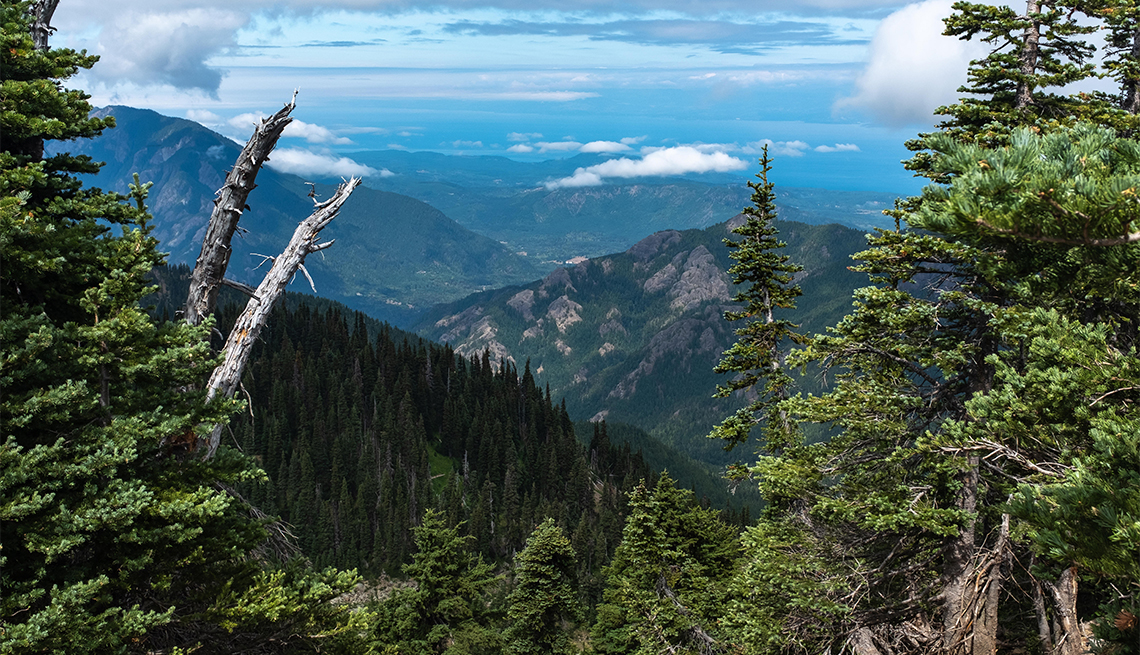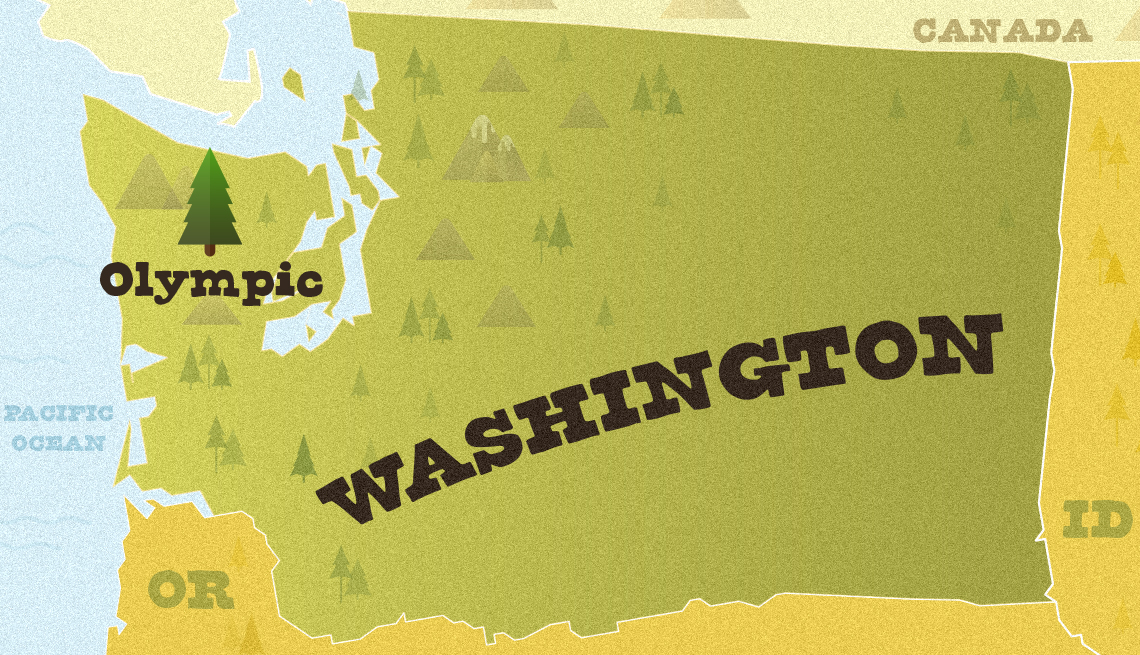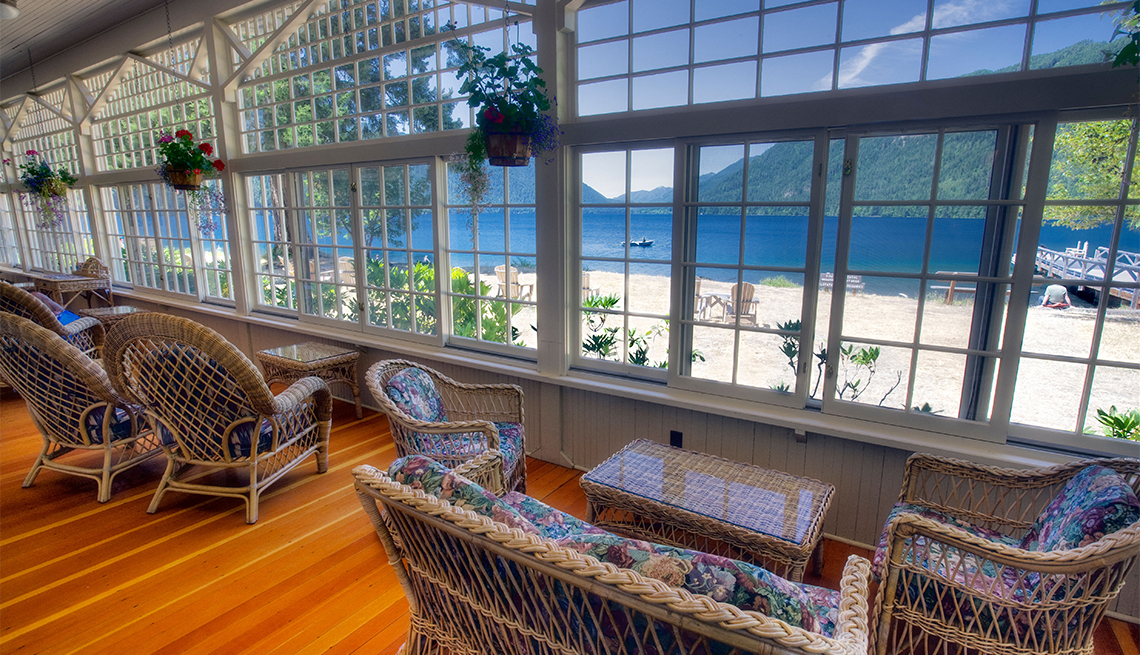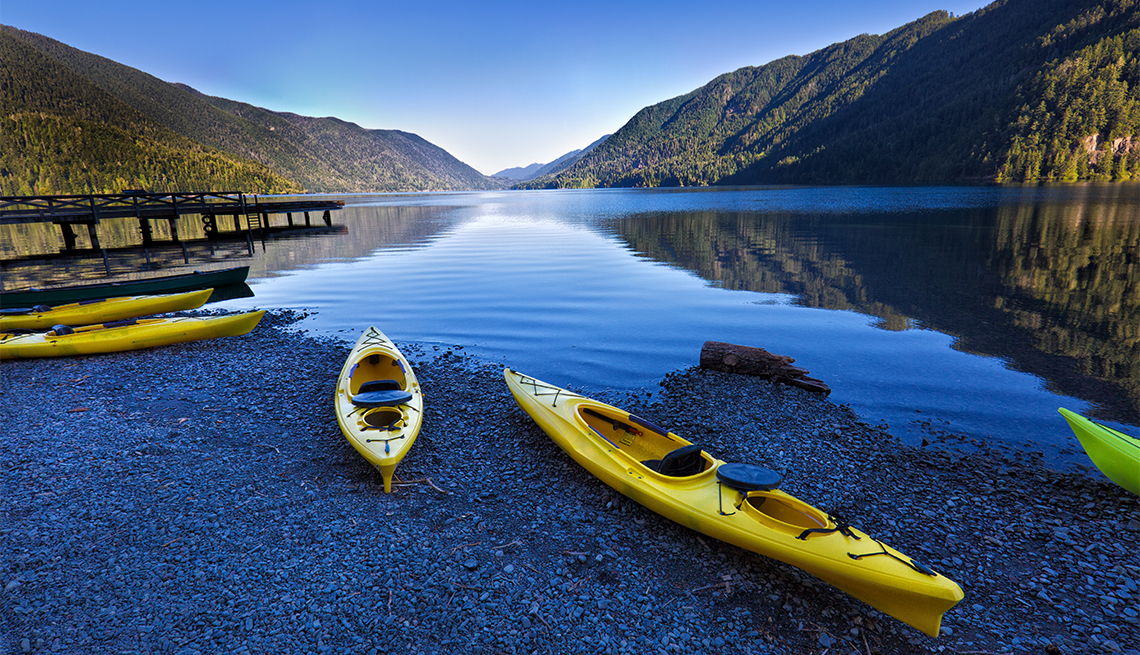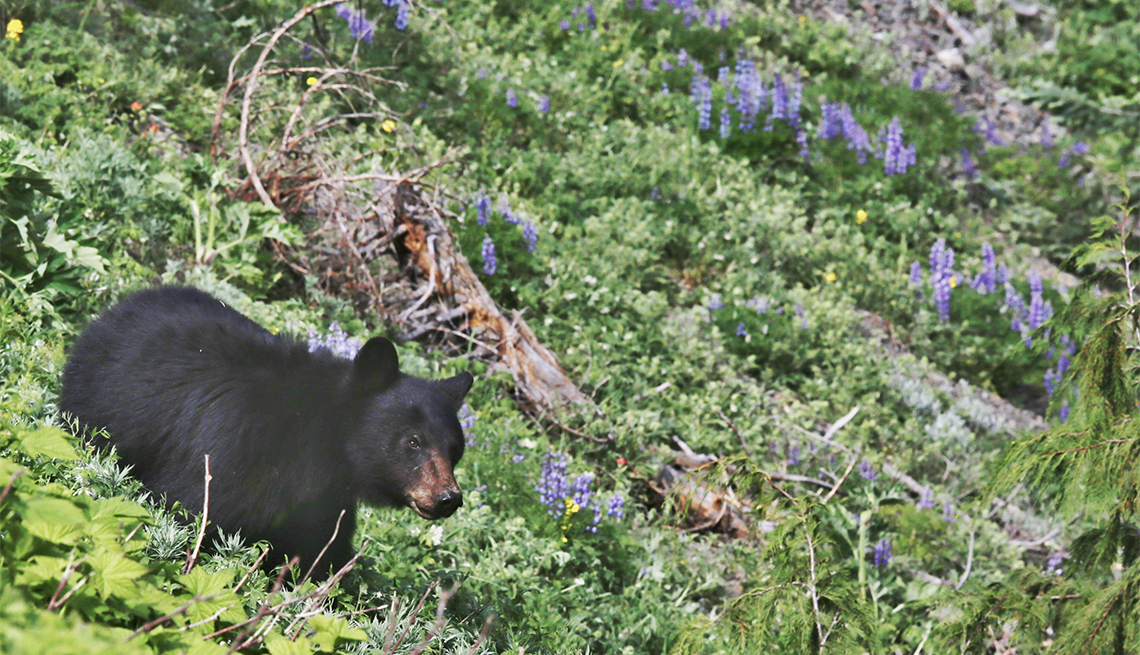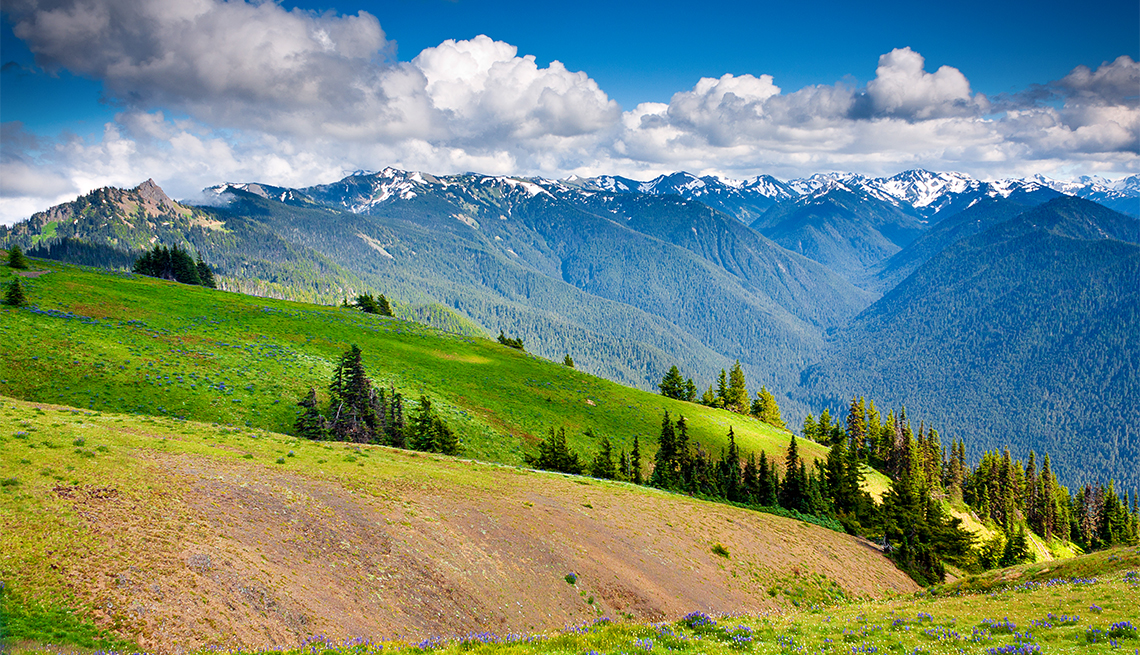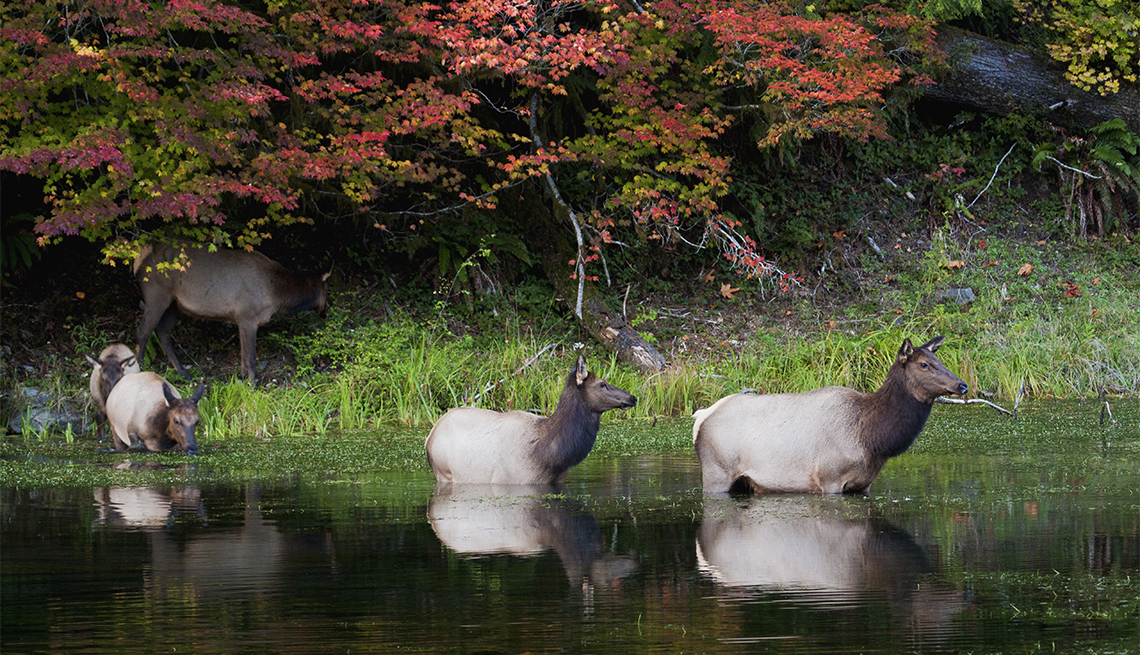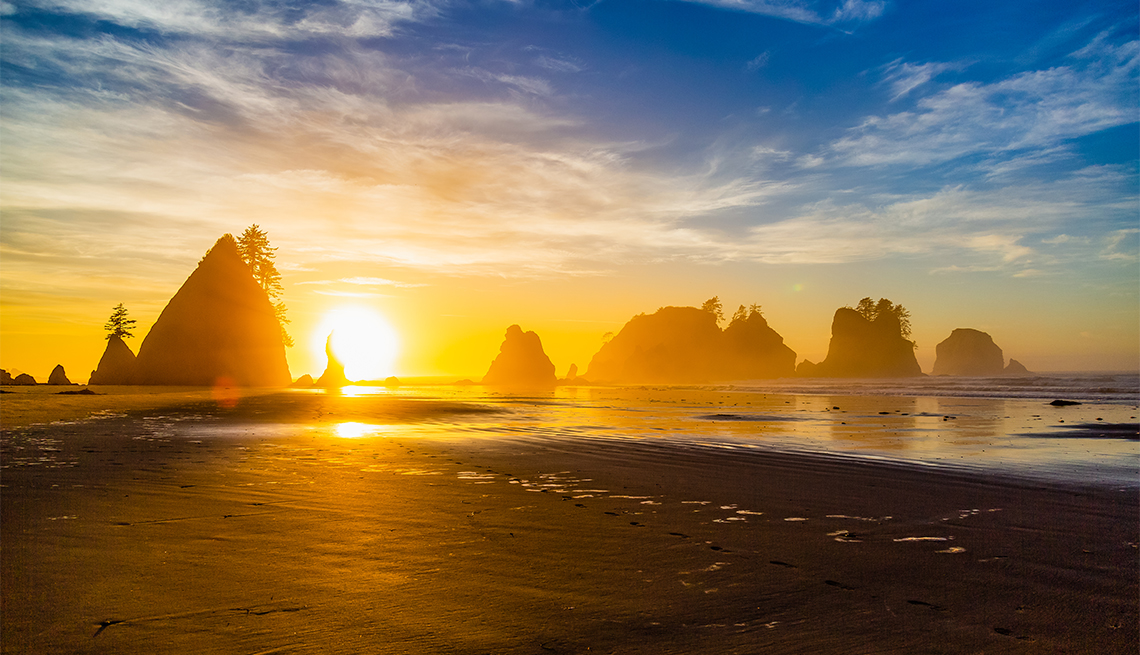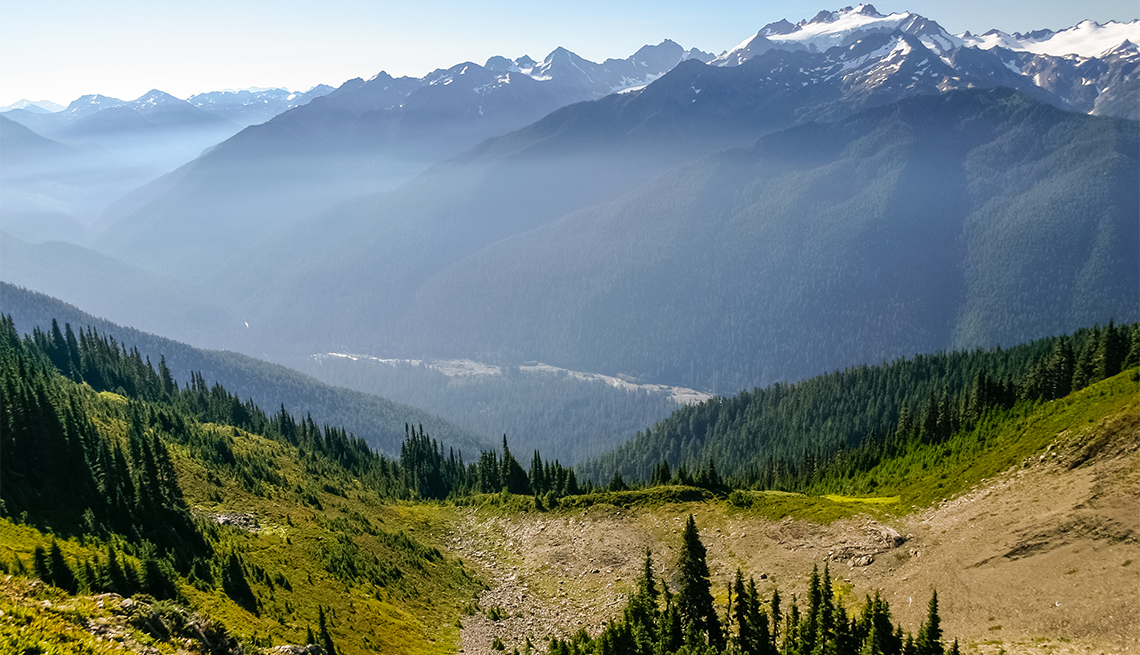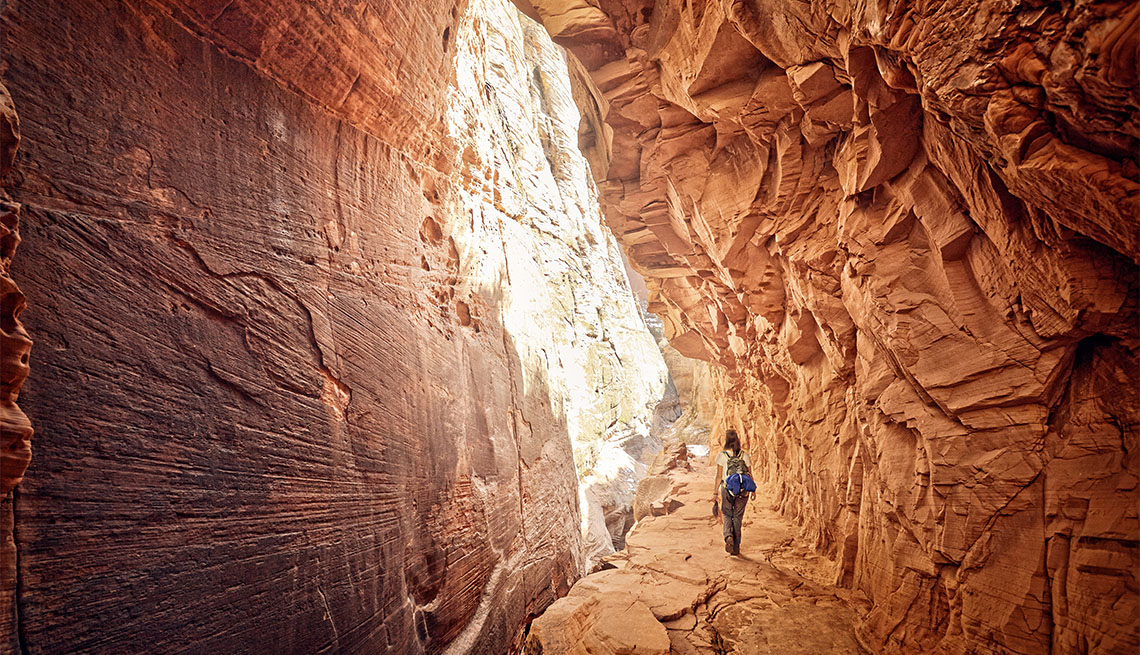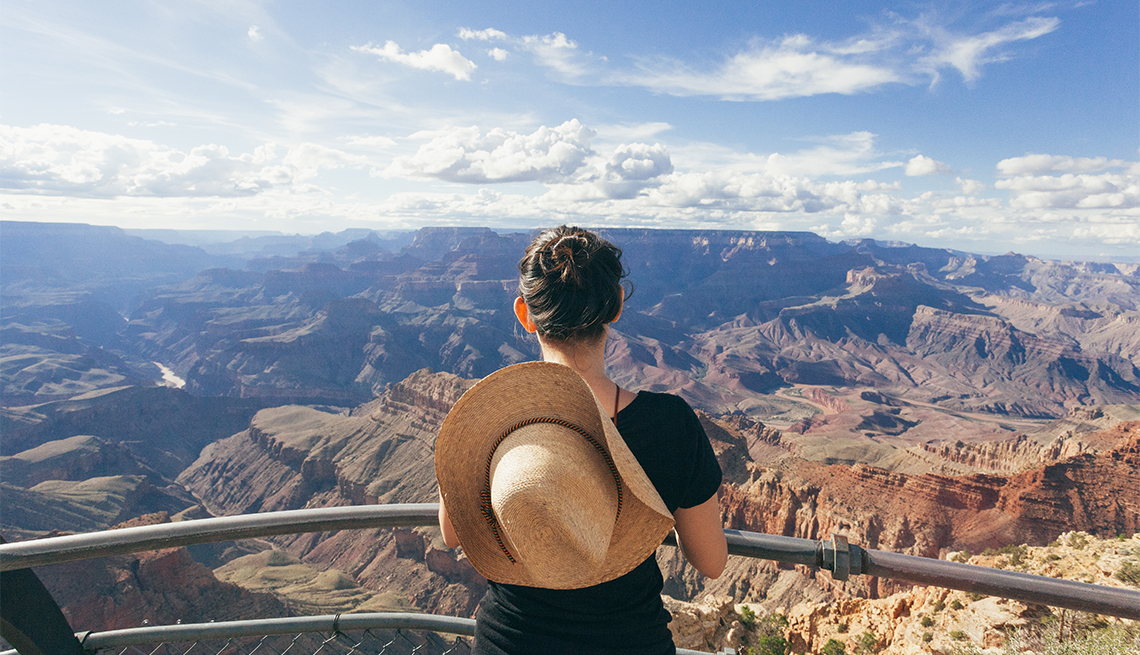AARP's Guide to Washington's Olympic National Park
Emerald wilderness, ancient trees, eagles, orcas and limited wi-fi
Pacific Ocean spray blends into misty rain forests at Olympic National Park on the Olympic Peninsula in western Washington. Sweeping from sea to rugged sawtooth mountains gilded by glaciers across more than 922,651 acres, the area is not just a national park. With its diverse ecosystems, it's also celebrated as an International Biosphere Reserve and a UNESCO World Heritage Site.
Eleven major rivers slice down from the Olympic Range, creating bountiful habitats for fish that migrate between freshwater and the ocean, such as steelhead and bull trout and the Northwest's five types of salmon. In turn, they fuel other keystone species, such as bears, eagles, orcas and otters.
The park also protects some of the world's finest remaining temperate rain forest: hauntingly beautiful and primeval old-growth that once stretched from California's Central Coast to Southeast Alaska. Some ancient trees flourishing here could be a thousand years old and stand 20 stories tall.
Then there's the ocean. Budget plenty of time to loaf along Olympic's western edge — 73 miles of the most primitive natural shoreline in the Lower 48 — says park spokesperson Penny Wagner. “Explore the wild beaches of the Pacific Coast, especially the tide pools and sea stacks: wave-sculpted stone monoliths in the surf that are truly breathtaking."
About 3.2 million people visit this Northwest sanctuary — created by President Franklin D. Roosevelt in 1938 — every year. While the backcountry appeals to hardcore adventurers, the park has plenty of accessible activities and scenic spots to suit young children and visitors with limited mobility. Whatever the activity, make sure to carry waterproof layers and quick-dry clothing — no jeans or cotton sweatshirts. The peninsula's conditions can turn on a dime, even on a warm sunny day.
Location: Western Washington's Olympic peninsula
Acreage: 922,651 acres
Highest peak: Mount Olympus, at 7,980 feet
Miles of trails: 611
Main attractions: Pacific coastline, temperate rain forest and glacier-gilded mountains
Entry fee: $30 per vehicle for seven consecutive days, $55 for the year or $80 for a lifetime America the Beautiful Pass for ages 62-plus
Best way to see it: driving punctuated by hikes
When to go to avoid the crowds: spring and fall
Plan Your Trip
ONP lies within easy range of Portland, Oregon, (163 miles to the south), and Victoria, British Columbia (37 miles to the north, largely via an international ferry). But most visitors depart from Seattle, which looms to the east across Puget Sound, a trip that takes two to four hours, depending on your mode of transportation and destination in the park.
Prefer driving from Seattle? Take a 111-mile road trip, swooping south around the Sound. Like the water? Hop on the city's Seattle-Bainbridge or Edmonds-Kingston ferries for a shorter, more scenic journey (both 94 miles to the park's eastern edges). Make sure to line up early during summer, holidays and peak weekends.
The park's road-free interior channels most visitors onto winding U.S. Highway 101. This classic route cradles Olympic's vast, amoeba-shaped central area, occupying the bulk of the peninsula, plus the thin Pacific Coast section to its west. Be prepared for seemingly short distances to soak up serious drive time, with many twists and turns. Cellphone reception fades in and out, so download digital maps for offline use. The park lodges and resorts also have no or limited Wi-Fi, making Olympic an especially good place to unplug.
Moving counterclockwise, the major gateway towns are Port Angeles to the north, Forks to the west and Hoodsport to the southeast.
Summer reigns as the sweet spot for park exploration. The warm, sunny season starts in mid-July and runs into September, with temperature highs of 65–75°F. Yes, you might see some fog, but it's still delightful.
That said, swathes remain emerald and temperate year-round, such as the coastline and four rain forests scattered throughout the park: the Bogachiel, Hoh, Queets and Quinault. “In a typical year, the park sees a lot of AARP-aged visitors just after Labor Day until mid- to late-October,” says Paul Thornton, northwest district manager for Aramark, which runs several park resorts. “The weather can be a little blustery,” he adds, but a great time to “enjoy the quiet after kids return to school."
Even winter antes in with skiing, sledding, snowshoeing and storm-watching. Note: From mid-October to May, some park routes and facilities close or have reduced hours, and drivers may need chains or four-wheel drive at higher elevations. Visit the park website or call 360-565-3131 for road and weather information.
Purchase passes before visiting to avoid long detours to ranger stations (the Port Angeles visitor center is the only one open year-round). Entry fee is $30 for seven consecutive days or $55 for the year. America the Beautiful Passes remain the best deal for park buffs. For $80, gain annual entry to more than 2,000 national parks and national wildlife refuges. That same price buys lifetime access for U.S. citizens and permanent residents age 62 and older.
You'll find plenty of restrooms throughout ONP and spots to rest on hiking trails.
Where to Stay and Eat
Built in 1915, Lake Crescent Lodge welcomes guests from late May through December in the park's north-central area. Expect original wood, a vast stone fireplace, screened-in sun porch and shoulder-mounts of majestic elk hunted long ago. At its waterview restaurant, which specializes in “farm to fork” cuisine and Pacific Northwest wines, don't miss the Dungeness crab corn cakes and marionberry cobbler with lavender-shortbread streusel. Nearby, the more affordable Log Cabin Resort appeals with its 1950s family-fun vibe and Sol Duc Hot Springs Resort cradles mineral soaking pools fringed by old-growth rain forest.
Just outside the park's northwestern area near Lake Ozette, the Lost Resort entices with a playful deal from mid-February to mid-May. Its rustic cabin rentals cost the same per night as the Fahrenheit temperature — which averages 45 degrees in winter — when you check in. When you're feeling parched, take your pick from more than 99 microbrews at its deli, which serves straightforward grub such as BLTs, breakfast burritos and burgers.
Twenty-five miles south, the Quileute Oceanside Resort & RV Park unfurls stunning ocean views. It also conveys a taste of the Indigenous culture that has thrived here for more than a thousand years, through its art and cultural traditions at community events.
The grand, gray-shingled Kalaloch Lodge overlooks a wilderness beach. From your room or cabin, you'll like the winter storm-watching and may even glimpse the gray whale migrations that peak in May. During summer, 60 percent of ingredients and beverages in the Creekside Restaurant are certified organic or sourced within 150 miles. Order the elk burger or dive into the sea's bounty with Korean salmon rillette or cavatappi pasta with local Dungeness crab and Beecher's Flagship Cheddar from Seattle's Pike Place Market. The property welcomes dogs ($25) — a rare perk in such a wild park.
Just outside the park's south-central region, Lake Quinault Lodge has the peninsula's most grande dame feel. Chill in the gazebo or Adirondack chairs overlooking its emerald lawn, which slopes down to the water. In the upscale dining room in the main 1926 building, savor everything from mushroom flatbread to seared duck breast.
Get closer to nature at one of the 14 campgrounds (permits $15 to $43 nightly) scattered throughout the park. Just know most are first-come-first-served and primitive — without year-round potable water and flush toilets — and the Dosewallips site requires a 6.5-mile hike in. Only Kalaloch, Mora and Sol Duc have the usual array of car-camping comforts and are the only ones that accept reservations (in the summer). Permits required for backcountry camping, as well. Visit recreation.gov for reservations and permits.
Things to Do
The park's interior has no roads, so drivers orbit its edges and thin coastal strip to the west. Budget at least three days to explore at a brisk pace — more if you plan to experience the coast, rain forest and mountains in any depth.
Take time to explore some of its 600-plus trails, encourages Donna Kreuger, who runs a Conditioning Hiking series in the park popular with women ages 50-plus. “Wildflowers, waterfalls, gorgeous rivers and abundant wildlife are all within the reach of the average person,” she says. “Due to the varied nature of the trails in the Olympics, it is possible to match anyone's fitness level to a great destination."
Coming from Seattle, most travelers start spectacularly at Hurricane Ridge, the park's most accessible alpine area. Set along the northern coast, it reveals panoramas of the Strait of Juan de Fuca and jagged peaks often cloaked in ice. At a mile high, this area can take your breath away, so ease into adventures from lift-skiing to guided full-moon hikes.
The half-mile Big Meadow and Cirque Rim trails are paved walks suitable for all fitness levels. You'll be rewarded with splendid meadow and mountain views. Or get more gonzo with the 3.2-mile Hurricane Hill trek, recommends Anna Roth, the hiking content manager for the Washington Trails Association. “The name makes it sounds pretty intense, but it's a mostly paved path leading from the visitors center to the summit of a nearby hill,” Roth says. “The trail has gorgeous views basically the whole way. Even if you don't make it to the top, you still get a nice vista. Plus, the wild flowers are A+ in the spring."
Below runs the Elwha River, site of the world's largest dam removal. Indigenous people, including the Lower Elwha Klallam tribe, led the push to restore this 45-mile waterway — once the peninsula's richest interior source of salmon. After the last concrete crumbled in 2014, transplanted coho and steelhead took root, and chinooks began migrating upriver. Visit the Glines Canyon open-air interpretive site to glimpse vegetation reclaiming a former lake bed, laced by an easy two-mile trail with just 50 feet of elevation gain.
Forty-seven miles west, at glacier-gouged Lake Crescent, hike in the Olympic foothills or take to the water with Adventures Through Kayaking. Bald eagles often wheel overhead as paddlers flank the Spruce Railroad Trail (10 miles round trip on foot and part of the bikeable 130-mile Olympic Discovery Trail). Soothe any sore muscles with a soak and massage at Sol Duc Hot Springs, a half-hour drive south. A pleasant, family friendly 1.6-mile hike also leads to a historic shelter and waterfall.
From there, head 90 minutes west to the longest stretch of wilderness shoreline in the Lower 48. Contrary to its subdued appearance, the Pacific teems with colorful fish, crimson anemones, orange sponges and purple sea stars here. Catch a glimpse in tide pools — while keeping an eye out for “sneaker waves,” which those famous Olympic beach logs can further weaponize. Three favorite spots: Beach 4 and Ruby Beach near Kalaloch, and Hole in the Wall, a sea-carved arch 1.5 miles north of the Rialto Beach Trailhead. But even a quick leg-stretcher from the parking lot to the shore can yield views of otters, sea lions and whales.
The beach and rain forest lie just minutes apart, spoiling visitors for choice. Don't get overwhelmed and miss the Hoh Rain Forest, a riot of ferns, fungus and trees with long shrouds of moss such as Grinch beards — all part of one of the Earth's most abundant areas of biomass.
The result: an enchanting, otherworldly landscape and a surprisingly serene one, too. Natural noises rule here, muffled by the ocean, the snowy crags and 239 cloudy days per year, plus the lack of highways and navigable rivers in the park's interior. For up to 20 minutes at a stretch, human racket dims and the terrain's heartbeat asserts itself.
Hit the Hall of Mosses trail, a 0.8-mile loop from the Hoh Rain Forest Visitor Center. Evergreens largely line this path, but pause and admire the grove of massive bigleaf maples frilled by epiphytic ferns and mosses. When autumn turns the trees’ leaves golden — usually in late October — it's a stunning spot for color photography. Pair this with the easy 1.2-mile Spruce Nature Trail, which leads down to the Hoh River and briefly flanks it. Roosevelt elk often linger there nibbling lichens and meadow grass. They're found only in the Pacific Northwest, which helped motivate Franklin D. Roosevelt to create the park in 1937.
Beyond hikes and scenery, ONP caters to more niche adventurers, too. Most fishing is catch-and-release, except in lakes above 1,300 feet (trout) and Ozette (bullhead, largemouth bass, northern pikeminnow and yellow perch). If you scuba dive, explore shipwrecks, crystal-clear Lake Crescent and the massive Olympic Coast National Marine Sanctuary (twice the size of Rhode Island).
ONP provides head-turning, jaw-dropping beauty around every bend, but don't forget to look up, too, suggests Craig Romano, author of Day Hiking Olympic Peninsula. “Night skies over much of the Olympics are pretty dark and ideal for stargazing,” Romano says. “And you don't have to hike deep into the wilderness to enjoy it. You can drive to the Deer Park Campground perched at 5,400 feet on Blue Mountain and delight in watching the night sky.”
AARP Membership -Join AARP for just $12 for your first year when you enroll in automatic renewal
Join today and save 25% off the standard annual rate. Get instant access to discounts, programs, services, and the information you need to benefit every area of your life.
Gateway Towns
Port Angeles serves as a hub for northern peninsula activities such as whale-watching and wandering along a charming mural trail. It also positions visitors well for park destinations, including Hurricane Ridge, Lake Crescent and Sol Duc Hot Springs. Drop in the Olympic Coast Discovery Center for information on the marine sanctuary and how to safely explore it.
Visit the northwest tip of the contiguous U.S. at Cape Flattery, just past the park's boundary. The Makah manage this area and Shi Shi Beach (insider tip: come here for dramatic photo ops when sunsets silhouette the sea stacks). To visit these areas, purchase a tribal recreation permit at Washburn's General Merchandise in Neah Bay, also home to a museum and ethnobotanical garden celebrating local Indigenous culture.
Forks is the gateway town closest to the Hoh Rain Forest and the park's tallest point: glacier-swathed Mount Olympus. The logging community first grew famous for the spotted owl controversy of the early 1990s — perhaps the fiercest fight in the history of the Endangered Species Act. Then it got a bite of luck from the Twilight vampire franchise, a series of blockbuster books and movies set in Forks. It still attracts diehard fans year-round, but especially during the mid-September Forever Twilight in Forks Festival. Skip the bloodsucking and refuel at the friendly Taqueria Santa Ana with homemade tortillas, spicy seafood and a standout salsa bar.
The Kalaloch area also makes a good staging point for the Hoh, as well as coastal must-sees such as Rialto and Ruby Beach.
Moving south and inland, Lake Quinault boasts a lodge, park campgrounds and tourist amenities within easy striking distance of alpine meadows. Boaters and fishers appreciate this destination, as do mushroom hunters and hikers.
En Route
Port Gamble makes for a pleasant stop if you're taking the Edmonds-Kingston ferry from Seattle. This former mill town won National Historic Landmark status for its Victorian district, a collection of New England-style homes presiding over elm- and maple-lined streets. Take a ramble or get more active kayaking on an Olympic Outdoor Center tour. Besides staggering views of the Olympic Mountains from out on the water, keep an eye out for harbor seals and porpoises. Time your trip just right and you could even stand-up paddleboard on a bioluminescent summer night.
If you're into high-end cuisine, stock up on gourmet salads, sandwiches, breads, cheese, charcuterie, duck eggs, pickled vegetables, farm-fresh produce and slab pies at the stellar Butcher & Baker Provisions. It even sells kimchi and spices such as harissa.
On soggy days, retreat to the retirement hot spot of Sequim ("Skwim"), 15 miles east of the park's main visitors center in Port Angeles, for lavender fields and Dungeness, a national wildlife refuge and one of the world's longest sand spits. A half-mile trail connects the forested bluff to the shoreline, then extends five flat miles to an 1857 lighthouse, which you can rent by the week. This region almost earns “desert” status with just 16 inches of rain annually — quite a difference from 12 to 14 feet on the nearby Pacific Coast.
If you make the drive around Puget Sound, explore the historic nautical town of Gig Harbor and Poulsbo, known for its Scandinavian-themed shops and restaurants. Then, 39 miles southwest, go for a paddle, scuba descent or beach walk along the 65-mile-long, fishhook-shaped Hood Canal. Two foodie standouts along this fjord: the Hoodsport Winery, which pours blueberry wine alongside classic Washington varietals; and Hama Hama Oyster Saloon in Lilliwaup, where the grilled oysters with chipotle-bourbon butter get raves.
- |
- Photos
Editor's note: This article was originally published on August 7, 2020. It's been updated to reflect recent COVID-19 developments.

